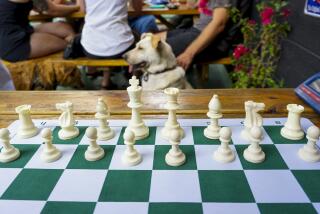Hikaru Nakamura is center of attention
- Share via
Jan. 24, 2010
Position No. 6091: Black to play and win. From the game Andreas Heimann-Pablo Lafuente, Basel 2010.
Solution to Position No. 6090:
White wins with 1 Nxf6+ Qxf6 2 Rd6! (crosspin!) Rxe4 3 Rxf6.
Unpredictable U.S. champion Hikaru Nakamura of Seattle has caused the most excitement at the Corus tournament in Wijk aan Zee, Netherlands. He started the tournament with 3-1, including the most brilliant game of the first four rounds.
World champion Viswanathan Anand of India and Magnus Carlsen of Norway, now ranked first in the world, also began 3-1. Alexey Shirov of Spain led with 4-0.
Nakamura’s modest result (no wins, one loss, six draws) in London in December gave no hint that he would erupt at the World Team Championship in Turkey with 6-2 (five wins, one loss, two draws) on first board against stiffer opposition. What’s next for the 22-year-old sensation?
Live coverage of the games begins daily at 4:30 a.m. PST at coruschess.com. Times reporter Peter Nicholas contributes reports at latimesblogs.latimes.com/sports_blog/chess. The tournament continues through next Sunday.
World Team Championship
The U.S. team finished second in the World Team Championship mostly because of outstanding performances by Nakamura and Alexander Onischuk (6 1/2 -2 1/2 on second board) of Virginia. Don’t dismiss the fine result as a fluke, though. The team succeeded despite a poor result (2 1/2 -4 1/2 ) on third board from usually- reliable Yury Shulman of Illinois and without former champion Gata Kamsky of New York, top-ranked in the country for most of the decade.
Varuzhan Akobian of North Hollywood was solid on fourth board, with two wins, one loss and five draws. And two debutants, 18-year old Robert Hess of New York and 15-year old Ray Robson of Florida, scored 1-1 and raised hopes for the Olympiad in Russia in September.
Local news
The Westwood Winter Open, a five-round tournament of 40-minute games, will be held next Sunday at the Los Angeles Chess Club, 11514 Santa Monica Blvd. in Los Angeles. Details are posted at westernchess.com.
The Joshua Tree Chess Club will conduct a four-round tournament of one-hour games Saturday in Faith Lutheran Church, 6336 Hallee Rd. in Joshua Tree. For information, contact Mark Muller at (760) 367-2311 or at [email protected].
A new chess club has begun in Murrieta. The club meets 6 p.m. to 9 p.m. Tuesdays in the home of Mihai Harabor at 38884 Cherry Point Lane. Call him at (951) 461-7578 for more information.
The best game prize in the recent Century West Open has been awarded to IM Tim Taylor for his victory over Allan Karman.
Today’s games
GM Boris Gelfand (Israel)-GM Hikaru Nakamura (U.S.A.), World Team Championship, Bursa 2010: 1 d4 Nf6 2 c4 g6 3 Nc3 Bg7 4 e4 d6 5 Nf3 0-0 6 Be2 e5 7 0-0 Nc6 8 d5 The Classical system against the King’s Indian Defense. Ne7 9 Nd2 Planning b2-b4, c4-c5 and Nd2-c4. Other lines begin 9 Ne1 and 9 b4. Ne8 Often Black disrupts White’s plan by 9 . . . c5 or 9 . . . a5. 10 b4 f5 11 c5 Nf6 12 f3 f4 13 Nc4 Success! But Black is happy too, as he can pursue a Kingside attack. g5 14 a4 Ng6 15 Ba3 Rf7 16 b5 In August, Beliavsky tried 16 a5 h5 17 b5 dxc5 18 b6!? g4 19 bxc7 Rxc7 20 Nb5. Although Nakamura won after 20 . . . g3 21 Nxc7 Nxe4 22 Ne6?! Bxe6 23 dxe6 gxh2+ 24 Kxh2 Qh4+ 25 Kg1 Ng3 26 Bxc5 e4, White missed two opportunities to draw, and possibly more by 23 fxe4 Qh4 24 h3. dxc5 17 Bxc5 h5 18 a5 g4 19 b6 g3 Threatening 20 . . . Nd7 and 21 . . . Qh4. 20 Kh1 Clearing g1 for the Bishop. White cannot survive 20 h3? Bxh3! 21 gxh3 Qd7 22 Qc2 Qxh3 23 Bd3 Nh4. Bf821 d6!? New. Nakamura wrote that he was inspired by a 2008 victory by Charbonneau, which finished 21 Bg1 Nh4 22 Re1? Nxg2! 23 Kxg2 Rg7 24 Nxe5 gxh2+ 25 Kh1 Nxe4. axb6 Inviting 22 axb6 Rxa1 23 Qxa1 cxd6 24 Rd1, as 24 . . . Ng4! 25 fxg4 Qh4 26 h3 hxg4 27 Rxd6 Bxd6 28 Nxd6 f3! 29 Bf1 Rf8 will gain a piece. 22 Bg1 Nh4!? White has defended h2, so Black shifts his sights to g2. Later games will investigate 22 . . . bxa5 23 dxc7. 23 Re1?! To parry 23 . . . Bh3 with 24 Bf1. However, 23 hxg3! fxg3 24 Be3 tests the soundness of Black’s attack. Black stands worse after 24 . . . Bh3 25 Rg1, or 24 . . . bxa5 25 Nxe5 Rg7 26 dxc7, or 24 . . . Bxd6 25 Nxd6 cxd6 26 Bg5. Nxg2! 24 dxc7?? Losing. Nakamura expected a draw by 24 Kxg2 Rg7 25 hxg3 Rxg3+ (the wild 25 . . . Qd7 26 g4 hxg4 appears promising for Black) 26 Kh1 Rh3+ 27 Bh2 Ng4!, when 28 fxg4 Rxh2+ 29 Kxh2 permits perpetual check by 29 . . . Qh4+. The outcome is less certain after 25 dxc7 Qe7 26 Nxe5. Nxe1! Relying on 25 cxd8Q g2 mate. 25 Qxe1 g2+! 26 Kxg2 Rg7+ 27 Kh1 Bh3! 28 Bf1 Qd3! Securing a material advantage, thanks to another threat against g2. 29 Nxe5 The better 29 Ne3 leads to a hopeless endgame by 29 . . . Bxf1 30 Qxf1 (not 30 Rd1? fxe3! 31 Rxd3 Bg2 mate) Qxf1 31 Nxf1 Rxc7 32 axb6 Rcc8 33 Ra7 Rab8. Bxf1! 30 Qxf1 Qxc3 31 Rc1 Qxe5 32 c8Q Rxc8 33 Rxc8 Qe6, White Resigns. Spectacular!
GM Vladimir Malakhov (Russia)-GM Yury Shulman (U.S.A.), World Team Championship, Bursa 2010: 1 e4 e6 2 d4 d5 3 Nd2 Tarrasch’s system against the French Defense. Nf6 4 e5 Nfd7 5 f4 c5 6 Ngf3 The main line is 6 c3 Nc6 7 Ndf3, reserving e2 for the other Knight. Nc6 7 Nb3 c4 Probably best. Black has also tried 7 . . . f6 and 7 . . . a5. 8 Nbd2 White has spent two moves to reduce the pressure on d4. b5 9 Be2 Nb6 Another plan begins 9 . . . Qb6 10 Nf1 f6. 10 Nf1 Bd7 11 Ne3 Be7 12 0-0 Qc7 13 Bd2 a5 Volkov tried 13 . . . f6 14 Be1 0-0 against Malakhov in 2001, but White broke through on the Kingside before Black accomplished anything on the other wing. 14 Be1 0-0-0?! Black should consider 14 . . . b4 or 14 . . . f5 before revealing his King’s hiding place. 15 b3! Threatening 16 a4. a4 16 Rb1 Qa7 Black cannot get his Rook to the a-file by 16 . . . axb3 17 axb3 Kb7, as 18 bxc4 bxc4 19 Bxc4! dxc4 20 Nxc4 strikes first. 17 bxc4 bxc4 18 Bf2 White has a large space advantage and good prospects on the Kingside. The open b-file complicates Black’s efforts to obtain counterplay. Na5? No better is 18 . . . Kc7? 19 f5!, when 19 . . . exf5 runs into 20 Rxb6! Kxb6 21 Nxd5+ Kb7 22 Qb1+ Kc8 23 Nb6+ Kc7 24 d5. Black must insert 18 . . . f5. 19 f5! Suddenly White is winning. If 19 . . . exf5 20 Rxb6! Qxb6 21 Nxd5 Qe6 22 Nxe7+ Qxe7 23 Qd2 Nb7 24 Bxc4, White’s Bishop and pawns are much more valuable than Black’s Rook. g6 A little tougher is 19 . . . f6, but 20 Nh4! fxe5 21 fxe6 Bxe6 22 Bg4 Bxg4 23 Qxg4+ Rd7 24 Nhf5 attacks relentlessly. 20 f6 Ba3 21 Ng5 Be8 22 Bg4! Announcing his intention to sacrifice at e6. Black cannot stop it. Even 22 . . . Kd7 loses to 23 Bxe6+ fxe6 24 Qg4. Nc6 23 Nxe6 fxe6 24 Bxe6+ Welcoming 24 . . . Bd7 25 Nxd5 Bxe6 26 Nxb6+ Kc7 27 d5 and 24 . . . Kc7 25 f7 Bd7 26 Nxd5+. Rd7 25 Nxd5 The less flashy 25 Rb5 Nd8 26 Nxd5 works too. Nxd5 26 Qf3 Nd8 27 Bxd5 Qa6 If 27 . . . Bf8, both 28 Bxc4 and 28 e6 are overwhelming. 28 e6 Seeing 28 . . . Nxe6 29 Bxe6 Qxe6 30 Qa8+ Kc7 31 Qb7+ Kd6 32 Rb6 mate. Rxd5 29 Qxd5 Nxe6 30 Bg3 Nc7 31 Bxc7 Kxc7 32 f7 Bd7 33 Qe5+, Black Resigns.

